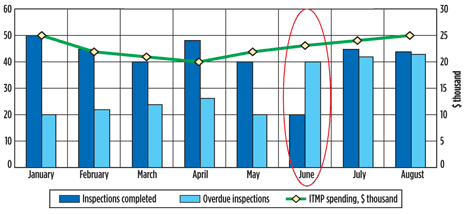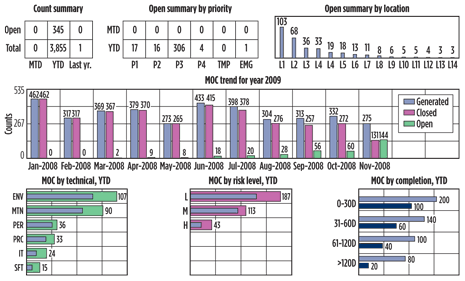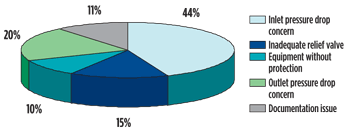Bringing offshore rigs, platforms into compliance with new US workplace safety regulation
Recommended practices related to safety and environmental protection become mandatory for OCS operators on Nov. 15. Effectively tracking key performance indicators and maintaining data can go a long way to meet the new requirements.
THOMAS AYRAL, KAUSHAL SHAH and DON NGUYEN, Siemens Energy Inc.
On Sept. 30, 2010, the US Bureau of Ocean Energy Management, Regulation and Enforcement (BOEMRE) announced two new rules designed to improve drilling safety by strengthening requirements for safety equipment, well control systems and blowout prevention practices in offshore oil and gas operations, and to improve workplace safety by reducing the risk of human error. To enforce these rules, BOEMRE plans to increase its number of inspectors by 30 to a total of 85, and is designing new training programs for inspectors. For the second rule, called the Workplace Safety Rule on Safety and Environmental Management Systems (SEMS), the agency issued a fact sheet that listed the 13 elements of API Recommended Practice 75 (RP 75) that the rule makes mandatory. These are: 1) general management program principles, 2) safety and environmental information, 3) hazards analysis, 4) management of change, 5) operating procedures, 6) safe work practices, 7) training, 8) quality assurance/mechanical integrity, 9) pre-startup review, 10) emergency response and control, 11) incident investigation, 12) SEMS element audit and 13) documentation and record keeping. Many of these elements appear similar to the Occupational Safety and Health Administration (OSHA) Standard 1910 elements, and therefore are familiar to many process safety management (PSM) personnel. SEMS applies to all outer continental shelf (OCS) oil and gas operations on new and existing facilities under BOEMRE jurisdiction including drilling, production, construction, well workover, well completion, well servicing and Department of the Interior-regulated pipeline activities. Operators of fixed platforms, mobile offshore drilling units, floating production systems, FPSOs, tension-leg platforms, spars and DOI-regulated pipelines must have the SEMS program developed, implemented, and available by Nov. 15, 2011. This article describes some of the steps that oil producing companies are taking or should be taking to comply with the new SEMS rules. MANAGEMENT MINDSET SEMS is a performance-based standard, lending itself to strict oversight. An operator’s management, thus, carries an obligation not only to decide on the means by which to achieve the goals but also to track adherence to the means deployed. Furthermore, SEMS explicates operators’ obligations by spelling out standards of the various elements described therein. For example, management must keep programs up to date and accurate for process hazard analyses (PHAs) and management-of-change procedures (MOCs)—two of the means required by SEMS to meet safety goals. Likewise, management is responsible for developing and endorsing a written program that addresses each of the 13 elements of SEMS.
Most companies recognize that change starts at the top. For example, one integrated major oil company stated, in an internal memo to its staff, that safety would be the sole criterion for rewarding employee performance in its operating business for the fourth quarter of 2010. Also, in informal discussions with employees of many large and small oil producing companies at a recent oilfield conference, several stated that, within the next few months, their companies are assigning a new leadership position with responsibility for complying with the new SEMS rule. These new employees will report at a high level and will have the responsibility and the budget to implement initiatives addressing the new rule. SAFETY AND ENVIRONMENTAL INFORMATION SYSTEM One of the SEMS requirements is to maintain accurate safety and environmental information, as described in Section 2 of RP 75. The management program should require that this information be compiled, developed and maintained for any facility subject to SEMS. Process, mechanical and facilities design information should be retained for the life of the facility. Operators must ensure that critical data for their facilities are accurate and accessible to all personnel whose job duties require their use. These critical data include process flow diagrams (PFDs), safe operating limits, process design material and energy balances, and mechanical and facilities design information. The design information encompasses piping and instrumentation diagrams (P&IDs), pressure relief, flare and safety systems, PHAs, mechanical integrity (MI) inspection and risk-based inspection (RBI), operating procedures, maintenance procedures, MOCs, document management, alarm data, project data, asset data, purchasing data, operating history, incident reporting, design codes and standard practices. For example, while conducting a PHA, a change in an alarm limit will trigger review of the P&IDs, PFDs, pressure relief systems, etc. In addition, the operating procedures will be changed and maintenance requirements will be enhanced. The changes will also require MOC monitoring and control. Note that most of the items listed under this critical data set are explicitly called out by OSHA 1910, which provides a persuasive precedent for how SEMS will apply in offshore operations. Most companies already have most of this data in various databases (silos), but they need it organized and made readily accessible. Inadequate maintenance of this information can lead to inaccuracies, which can harm the results of PHAs, waste valuable personnel time and even lead to fines or casualties. One key action that will increase critical data accuracy is implementation of an MOC system that is user friendly and easily understood by all levels of personnel at a facility, preferably an electronic system to allow for streamlined approvals and MOC status visibility. For accessibility, a central data repository system should be implemented that compiles the critical data from the different silos and allows for data comparison so differences or exceptions can be easily identified and verified for accuracy. For monitoring of overall compliance, key performance indicators (KPIs) should be designated that will provide a measure of the wellness of the facility SEMS program.
The ability to present KPI data in a dashboard can enhance management’s ability to monitor the level of compliance with the SEMS rule. KPIs for process safety management may include inspection performance, operational risk, MOC performance and pressure relief deficiencies. Inspection performance. Figure 1 indicates a high number of overdue inspections every month, suggesting that proper resources were not devoted to equipment inspection. For June, the number of overdue inspections doubled while the number of conducted inspections remained the same. This suggests that more resources should have been devoted to inspection testing and preventive maintenance (ITPM) activities. For July and August, the number of conducted inspections increased, but not nearly enough to offset the number of overdue inspections. Operational risk. As shown in Fig. 2, Site 1 has more equipment with high corrosion rates than other sites, suggesting higher-risk processes are involved. Higher corrosion could also be caused by equipment operating envelopes being exceeded. MOC performance. MOC activity can be tracked by frequency of events per location, by duration and by risk level, Fig. 3. MOC metrics are useful indicators of an operator’s risk tolerance. Pressure relief. As shown in Fig. 4, KPIs related to pressure relief analysis include the number of deficiencies in a given process unit and the breakdown based on type of deficiency (e.g., inlet pressure drop, inadequate relief valve, equipment without protection). The rig management can use this data to compare the type and number of deficiencies among other sites. Management should develop a mitigation action plan for all deficiencies and implement each plan accordingly. The KPI will alert management of the high-risk deficiencies, like “equipment without protection,” and thus dictate the implementation order. Similar KPIs can be generated for PHA and maintenance performance. Besides measuring process-related KPIs, the performance indicators listed in Appendix E of API RP 75 should be measured to optimize safety and environmental management. PRESSURE RELIEF MANAGEMENT A pressure relief system is part of the “safety and environmental information” element in RP 75, made mandatory by SEMS. As global facilities continue to increase capacity to keep pace with worldwide demand, operators must keep a watchful eye on process safety—in particular, management of pressure relief systems. These systems serve as the final layer of protection when other control mechanisms have failed. Pressure relief incidents come at an enormous cost, not only to the company’s business, but also to workers and nearby communities. Typical compliance audits that focus on individual valves and systems may miss a critical fault in a vital piece of equipment and aren’t likely to address all the scenarios through which an overpressure incident may unfold. Equipment-based methodology is the best practice to examine the critical relationships between individual pieces of equipment and relief devices, by calculating the required relief rates and relief capacity and documenting deviations from industry standards and practices. There has been a trend in recent years, particularly among the major oil companies, to adopt and standardize commercial pressure relief software. The trend has been driven, in part, by intense regulatory scrutiny, as well as corporate concerns related to HSE, security, disaster/loss, increased capacity and performance/reliability. The move toward software can also be attributed to the natural evolution of business processes toward centralization and automation. A software application that provides a systematic approach to mitigating risk and improving overall safety and efficiency of the operation will be able to capture the relationship between overpressure scenarios, process equipment and specific relief devices, and to calculate required relief rates based on API and Design Institute for Emergency Relief Systems (DIERS) methodologies. Connectivity to third-party hydraulic solvers to determine backpressure profiles is also recommended. A centralized data repository of equipment and associated relief devices, and common or customized overpressure scenarios for each piece of equipment, should be readily available. Such an application should also create hypothetical, planned or alternate mode-of-operation case studies with ease. Combining best-practice methodology and appropriate software can help ensure high levels of safety and also reduce the risk of noncompliance, downtime and lost production. The software should provide the information required in a SEMS audit pertaining to pressure relief. Because the data is centrally located, it could more easily be maintained evergreen via the MOC process. A change in the hydraulics of the mud pumps has immediate impacts on the operations of downstream equipment. Under the new rule, a change awareness notification must be signed by every employee who is impacted by the change.MECHANICAL INTEGRITY MI, another of the 13 elements in RP 75 made mandatory by SEMS, includes all of the activities used to ensure that critical equipment for any facility is suitable for its intended operation or fit for service. A successful MI program requires: As process facilities and rigs age, improving MI programs becomes increasingly critical. Implementing inspection data management systems (IDMSs) and risk-based inspections (RBIs) and conducting audits can help improve an MI program. Inspection data management. An IDMS is one of the most important contributors of critical data, such as equipment and piping design parameters, operating conditions, corrosion rates, thickness measurement locations, thickness readings, isometric drawings and testing frequencies. For example, a gas/oil separator in an offshore facility remains in service for several years. The vessel and any other auxiliary package equipment should be in the IDMS. In the offshore area, the inspection plan should be laid out far in advance to ensure availability of resources on scheduled milestones. Lumping inspection activities with better planning eases scheduling pressure on the operators. Likewise, linking inspection drawings to equipment and automatically displaying TML information on the drawing allows for a time-efficient inspection of all the equipment. Risk-based inspection. An RBI program uses relative risk to prioritize and manage inspections. Risk is a function of the equipment’s likelihood and consequence of failure due to damage mechanisms, which may include corrosion, cracking and fatigue, among others. Risk tolerance levels can be used to optimize inspection techniques, coverage and frequency for each piece of equipment. An RBI implementation utilizing an effective IDMS application optimizes inspection and maintenance resources. It prioritizes high-risk equipment while perhaps deferring or reducing inspections on low-risk equipment. The end results are improved plant safety and equipment reliability, as well as more efficient shutdowns and turnarounds, when required. HAZARD ANALYSIS AND AUDITS One of the approaches being suggested for SEMS compliance is called the “safety case.” This approach puts the burden on companies to prove to regulators that they have identified risks and have developed procedures to cope with them. Process hazard analysis (PHA) follows methodologies in API RP 14J, “Recommended practice for design and hazard analysis for offshore production facilities.” Hazard analysis requirements for production equipment may be met by ensuring that the facility conforms to API RP 14C, “Recommended practice for analysis, design, installation and testing of basic surface safety systems on offshore production platforms.” To implement this approach proactively, some companies employ independent auditors or consultants to perform an audit and identify risks. These consultants must have a great deal of experience performing audits (e.g., former OSHA auditors). This gives the operating company an independent view as well as the time to develop corrective procedures. These audits are normally completed within a few weeks. The rule (30 CFR 250.1911 (a)) requires that each operator perform an initial hazard analysis on each facility on or before the deadline. However, an operator may use an existing hazard analysis as long as it reflects the complexity of the current operations being conducted and shows all modifications. This is another example where having a functioning MOC system in place can save operators time verifying accuracy of data. During drilling, mud circulation can result in hydrocarbon shows at the surface, requiring separation and venting. During well tests, again a significant amount of hydrocarbon is being brought to the surface. The systems that support these operations (mud/gas separators, pumps, relief and vent gas systems, process controls, fire and gas detection, etc.) must be designed appropriately. The PHA process as described in SEMS can ensure that risk identification and consequence mitigation are incorporated starting with the design stage. PHAs typically involve multidisciplinary teams including engineers, operators, contractors, environmental, health and safety personnel, and project management. The team is tasked with analyzing potential causes and consequences of fires, explosions, releases of toxic or flammable chemicals, and major spills of hazardous chemicals, and it focuses on equipment, instrumentation, utilities, human actions and external factors that might impact the process. SEMS requires operators to do a PHA for each of their facilities. MANAGEMENT OF CHANGE Companies often utilize a software package to enforce the MOC procedures required under SEMS. To illustrate the utility of such software, an oil company recently reported that, when utilizing a paper-only system for MOC, 10 out of 20 circulating MOC document packages were permanently lost during the MOC process. An MOC software package should have the functionality to track MOC recommend-ations from any source along the line from input to closure. It should maintain critical MOC documentation and create a clear, auditable trail that helps ensure critical elements of regulatory compliance and makes certain that potential risks from process modification are addressed. It should allow remote access from various locations and associate risk level with approval requirements. Consistency in the technical review of the change should be driven by standardized checklists to perform engineering, safety, health and environmental reviews. MOC software should also work with the company e-mail system to routinely notify process holders of assignments and deadlines. Changes in operation or equipment of a drilling rig must be captured through an MOC system to ensure that the operator and support staff are aware of the current as-built status of these systems and can respond accordingly in the event of an incident. Because the SEMS elements are so intertwined, it is essential to propagate approved modifications to all of the documents where the information resides. For example, if there is a change in the alarm set points of the blowout preventer or in the hydraulics of the mud pumps, the change must progress through the proper approvals and a change awareness notification must be signed by every employee who is impacted. In the case of mud pump hydraulics, this change has immediate impacts on the operation of downstream equipment. In these and other cases, following proper change procedures will help reduce risks and decisions based on inaccurate information. Often, the change is hard to communicate because of shift rotations and personnel turnover. However, it must be done. In addition, the approved change must be updated on the P&IDs, distributed control system, PHA, operating procedures and critical alarms list. Per 30 CFR 250.1912 (a)(3), an MOC is necessary for personnel changes, including contractors. An MOC would occur whenever there is a change in personnel that supervise or operate the facility, including routine vacancies and replacements, crew rotation, and shift and tour changes. CONCLUSIONS BOEMRE will enforce SEMS as an integrated management system, which to function properly needs all elements to be developed and implemented. The agency does not anticipate an operator developing its SEMS compliance program in a piecemeal fashion. A comprehensive plan that concurrently addresses all of the SEMS elements is the best solution. The nature, frequency and level of detail of federal inspections will probably increase, and proactive companies are making the changes to comply now. Because failure to comply with SEMS may lead to civil penalties or the initiation of probationary or disqualification procedures preventing operators from working on the OCS, starting early is recommended to ensure full compliance by Nov. 15.
|
|||||||||||||||||||||
- Advancing offshore decarbonization through electrification of FPSOs (March 2024)
- Subsea technology- Corrosion monitoring: From failure to success (February 2024)
- Prices and governmental policies combine to stymie Canadian upstream growth (February 2024)
- U.S. producing gas wells increase despite low prices (February 2024)
- U.S. drilling: More of the same expected (February 2024)
- U.S. oil and natural gas production hits record highs (February 2024)
- Applying ultra-deep LWD resistivity technology successfully in a SAGD operation (May 2019)
- Adoption of wireless intelligent completions advances (May 2019)
- Majors double down as takeaway crunch eases (April 2019)
- What’s new in well logging and formation evaluation (April 2019)
- Qualification of a 20,000-psi subsea BOP: A collaborative approach (February 2019)
- ConocoPhillips’ Greg Leveille sees rapid trajectory of technical advancement continuing (February 2019)



.gif)


 TOM AYRAL is a Business Development Manager for Siemens Oil & Gas Consulting with over 30 years of experience in bringing new technology to the oil and chemical industries. He has a BS degree in chemical engineering and an MBA. Mr. Ayral specializes in preparing business cases and financial value propositions. /
TOM AYRAL is a Business Development Manager for Siemens Oil & Gas Consulting with over 30 years of experience in bringing new technology to the oil and chemical industries. He has a BS degree in chemical engineering and an MBA. Mr. Ayral specializes in preparing business cases and financial value propositions. /  KAUSHAL SHAH is a Senior Engineering Consultant for Strategy at Siemens Oil & Gas Consulting. He has 12 years of experience encompassing strategic growth, engineering management, project management, relief system design and evaluation, process simulations and risk mitigation. /
KAUSHAL SHAH is a Senior Engineering Consultant for Strategy at Siemens Oil & Gas Consulting. He has 12 years of experience encompassing strategic growth, engineering management, project management, relief system design and evaluation, process simulations and risk mitigation. /  DON NGUYEN is the Principal Process Safety Management Engineer for Siemens Oil & Gas Consulting. He has almost 25 years of experience conducting OSHA compliance inspections, especially with regard to fire and explosion investigations. Both OSHA and the US Department of Labor have issued him special achievement awards.
DON NGUYEN is the Principal Process Safety Management Engineer for Siemens Oil & Gas Consulting. He has almost 25 years of experience conducting OSHA compliance inspections, especially with regard to fire and explosion investigations. Both OSHA and the US Department of Labor have issued him special achievement awards.
